The Archos 101 XS Review: Prettier, Faster, So Much Better
by Jason Inofuentes on August 22, 2012 12:15 PM ESTDisplay
We’ll start with that most vital of tablet components, the display. We had a chance to chat with Archos ahead of this review to nail down some details about the new line. Seems that they still had several of that same 10.1” 1280x800 MVA panel, so we’re actually seeing the same display as in the G9s. We weren’t entirely dissatisfied with the G9 displays, though we did experience some poor contrast and odd viewing angles in the 101 G9 Turbo. The backlight seemed to be at fault in the contrast issue, but MVA panels should have good viewing angles so the imperfect ones we were seeing were surprising. In the XS both issues seem to have been resolved, and I suspect that has something to do with a different touch layer and backlight.
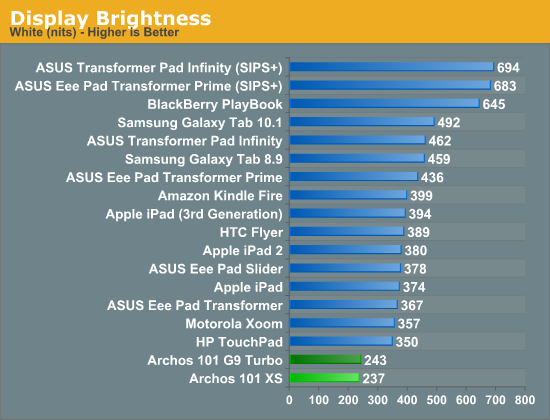
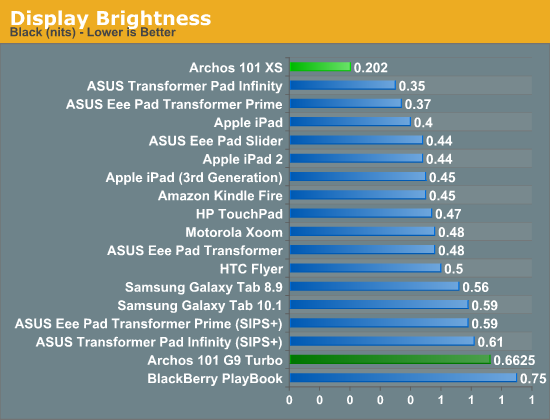

The rest of the results aren’t far off from the prior generations displays. MVA panels sacrifice brightness for good black levels and contrast. Color reproduction takes a pretty significant hit, though it’s unclear if that can’t be chocked up to software. Like the G9s then, this will suffice for watching a movie or playing a game inside, but take it outside and things could get pretty rough.
Keyboard and Accessories
The G9 Turbos hadn’t yet launched when we started hearing about Archos impossibly thin next-generation tablets, which would be a Transformer competitor with an ultra-thin keyboard dock. This, it turns out was a pretty solid rumor. I question though the validity that this is a true Transformer competitor. The Transformer’s dock creates a clamshell style device, effectively a netbook, and benefits from additional connectivity and an additional battery inside the dock. The Archos 101 XS draws from countless “keyboard cases” for the iPad and other tablets; a thin, flat keyboard with concealed magnets that match with magnets within the XS to cover the front of the device, and a mechanism for docking the XS when in use. The keyboard weighs almost nothing so there’s no weight penalty for carrying it around, but at the expense of an auxiliary battery.
I’ve got thick fingers and have never been content with anything but a standard full-sized keyboard, so I’m honestly just a poor judge of how comfortable it is to type with the XS keyboard. The keys are slightly smaller than your standard chiclet keyboard, and though the travel distance is sufficient, they feel a bit soft; it’s hard to tell when you’ve actuated the key. An assortment of Android specific keys line the top and bottom rows, and the bottom right of the device suffers some crowding in order to fit in the directional keys. The abbreviated right shift key was particularly irksome, as I consistently moved the cursor up mid sentence. After a few hours of use, I was able to get a fair amount of writing done on the keyboard, but given the option, I’d just as soon use my laptop.
The pogo pins on the XS and the exposed magnets line-up with a similar set on the keyboard dock, but the rather flat dock uses a dual-hinged flap, equipped with its own magnet, to keep the XS upright. Moving the point of contact of the flap up and down along the back of the XS gives you some control of the angle of the device, but not much. Set the XS too far back, and the pogo pins lose contact and you have to reseat the device. Weight becomes an issue, too. Though the XS is quite light, it is still much heavier than the dock, so the combination is top heavy and sits precariously on a lap.
Fans of Archos are no doubt saddened at the loss of their beloved kickstand, but fear not. There are two other accessories planned for release not long after the XS debuts. Both will utilize the pogo pins on the bottom of the device, and take the form of media stands. The first is a complete solution with speakers while the other will be similar but with an audio out so users can connect their own speakers. I expected that Archos wouldn’t sacrifice the kickstand without offering something in return; and as someone that’s been known to watch streaming content on a tablet as I move from room to room in my house, the concept of having a few well placed docks scattered around the house seems perfectly plausible.


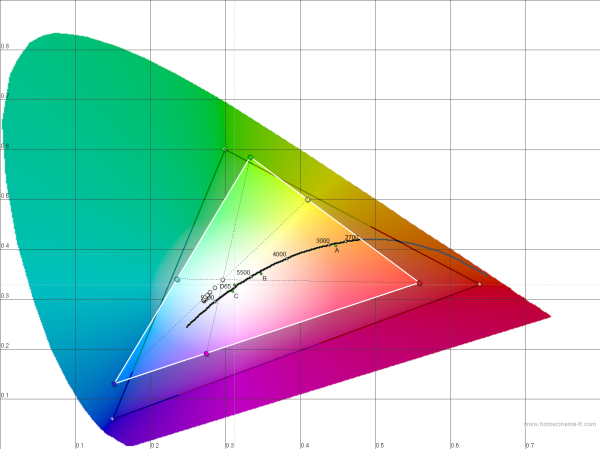
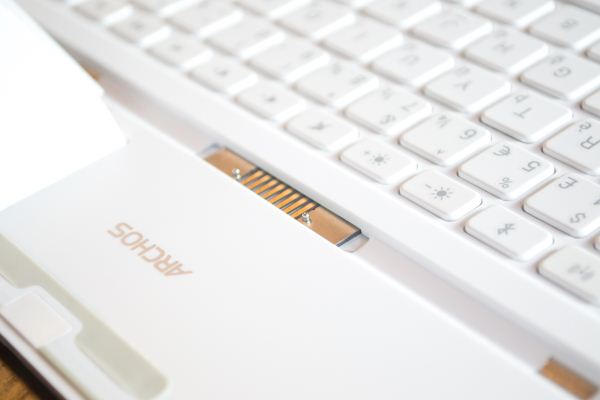
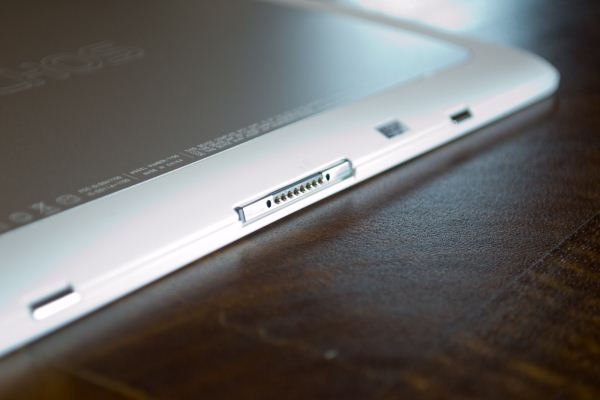
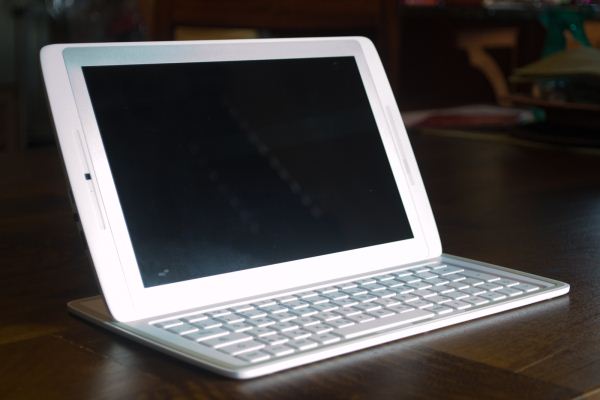








44 Comments
View All Comments
scavio - Friday, August 24, 2012 - link
Both the Galaxy Nexus and Nexus 7 got Jellybean at essentially the same time, the Nexus 7 just happened to launch with it.JasonInofuentes - Thursday, August 23, 2012 - link
The question isn't whether it undercuts the price of having a keyboard, it's the value of that total package. I think many would argue that the TF300 with keyboard is a better value because the TF300 is an overall better package, AND the keyboard has massive supplemental battery. The other comparisons creep a little too close to what one could be paying for a fair Ultrabook. Those then become a choice between sacrificing performance for portability or paying more for a better notebook-style device. So, yes, we should have perhaps spent more time discussing the value add that a bundled keyboard brings, we're just not sure how much the keyboard will add to the experience. If you read the other reviews out there, opinions on the keyboard are pretty scattered. Some hated it. Others loved it. I didn't mind it.As for the prospects of a big Q4 for OMAP 4470? We don't like to speculate on what SoC will find a home in rumored devices, but let's consider that TI's place in the release cycle is last. NVIDIA has set a very fast tempo, though they've had two generations of A9 SoCs. Qualcomm is equally fast, and have already premiered their A15-class SoC, and working towards releasing their second iteration. Samsung is preparing Exynos 5 for an early '13 release, and have rolled out Exynos 4 Quad to sate us until then. And TI will have OMAP 5 in early '13, but has OMAP 4470, an SoC we reported on a year ago, to fill the gap.
There's nothing wrong with OMAP 4470, indeed it should give us a good picture of what OMAP 5 should look like. The inclusion of the CGPU and the focus on 'smart multicore' versus simply squeezing more A9 cores into the device is something that might win it more design wins in the mid-range space. Though SoCs only add a small amount to bill of materials, there's likely a premium, based on availability, in putting a quad-core SoC in your device versus a dual-core SoC. We do know that OMAP 4470 will see a lot of play in the Windows RT space. And in talking with TI they seem excited about this Fall, so perhaps you're right; perhaps we will see some TI-driven Nexus devices, and a myriad of other brands. I just don't think they'll be in the highest end devices.
yyrkoon - Monday, August 27, 2012 - link
TI is great to work with in the embedded field. Their hardware is not bad, and they do a lot of the development grunt-work for would be designers. Offer great, and sometimes free software tools . . . Plus they contribute a lot in some areas to the OSS community. For their products of course.So yeah I have to think TI based parts are going to be seeing a lot of play in future embedded applications. This makes me excited too. Since I really enjoy working with TI hardware.
Malphas - Saturday, August 25, 2012 - link
Or are they just jumping on the bandwagon? I owned a G8 tablet and it was completely solid, as well as dirt cheap and running a stock ROM with no bloatware refreshingly. It would be more enlightening to hear what percentage of G9 users - and Archos users in general - are satisfied/unsatisfied with their devices rather than just people badmouthing them on forums based on reviews but no actual experience with the product.